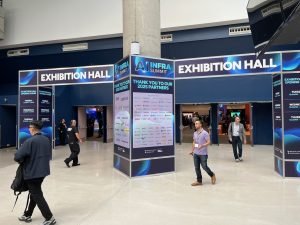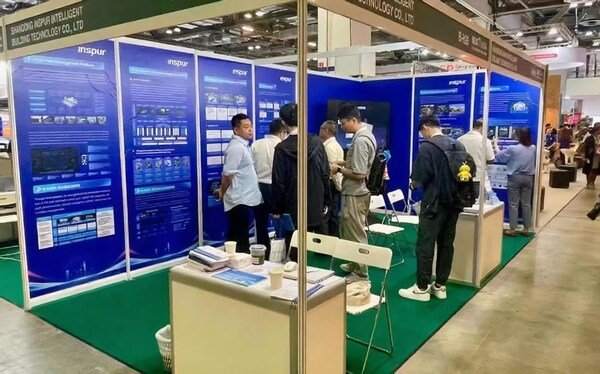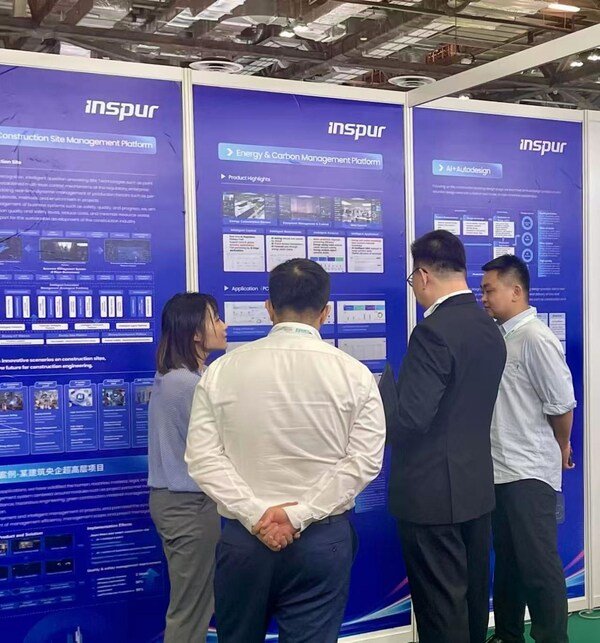Tools & Platforms
‘Kicking our butts’: Rapid pace of AI development sparks an urgent push to build better infrastructure

Artificial intelligence innovation is moving at warp speed, but major tech industry players are sounding alarm bells that infrastructure is failing to keep pace with advancements in the field.
“AI is kicking our butts and teaching us that we know nothing” about infrastructure, Yee Jiun Song (pictured), vice president of engineering at Meta Platforms Inc., said Tuesday at the AI Infra Summit in Santa Clara, California.
Zeroing in on the fundamental disconnect, Dion Harris, senior director of AI and HPC Infrastructure Solutions at Nvidia Corp., also noted at the conference that though new AI models are being introduced every week, the time frame for building out the infrastructure to support AI is currently measured in years.
“We have to get everyone else to be prepared for where we’re going,” Harris told the gathering. “The biggest challenge is making sure that everyone is ready to come with us. There is this misalignment of time scales. That in and of itself is a challenge.”
Nvidia previews faster inferencing processor
For its part, Nvidia Tuesday previewed an upcoming chip, the Rubin CPX, that is designed to provide 8 exaflops of computing capacity for AI inferencing. According to the chipmaker, the Rubin CPX will be able to optimize certain mechanisms for large language models three times faster than its current-generation silicon. It’s part of Nvidia’s philosophy that an investment of several million dollars in infrastructure can generate tens of millions in token revenue.
“The performance of the platform is the revenue of an AI factory,” Ian Buck, vice president of hyperscale and high-performance computing at Nvidia, said during a keynote appearance. “This is how we feel about inference.”
More than 3,000 attendees participated in the AI Infra Summit in Silicon Valley this week.
Though Nvidia’s latest chip will help boost computing capacity for AI inferencing and specific LLM tasks, the scale of AI adoption is forcing model providers to invest hundreds of billions of dollars to build out new data center clusters. One of the more notable examples of this is the Prometheus supercluster under development by Meta. Scheduled to come online in 2026, the Ohio-based facility will be one of the first gigawatt data center clusters in the AI era.
“Meta is now only one of a few companies that are racing to build data centers at this scale,”
Song said. “There never has been a more exciting time to be working in infrastructure.”
Prometheus is just a warm-up for future data center clusters in the planning stage. Meta has also announced Hyperion, a second data center cluster that is expected to require up to 5 gigawatts of power. Although Meta has not announced a date for Hyperion’s completion, one industry leader is already questioning whether clusters of this size will meet the global demand for AI processing.
“I don’t think that’s enough,” said Richard Ho, head of hardware at OpenAI. “It doesn’t appear clear to us that there is an end to the scaling model. It just appears to keep going. We’re trying to ring the bell and say, ‘It’s time to build.’”
AI agents drive need for the right stack
Increasing adoption of agents for enterprise tasks is one factor behind the urgency in building the infrastructure to support AI deployment. Large tech players such as Amazon Web Services Inc. are making major investments in agentic AI, fueling rapid advancement of what the technology can ultimately do.
Though one of the key use cases is currently “agent-assisted” application development, the technology is expected to progress rapidly toward “agent-driven” solutions, which will place further demands on infrastructure, according to Barry Cooks, vice president of compute abstractions at AWS.
“The expectation here is this will just continue to expand,” Cooks said during an appearance at the conference. “We’re in the midst of a huge change in the technical landscape in how we do our day-to-day work. It’s super-important that you have the right stack.”
Having the right stack will require new approaches in how systems are architected, a challenge that is being addressed in areas such as memory. For AI processors to function effectively, they need rapid access to data, driven by temporary storage such as dynamic random access memory or DRAM. If DRAM is slow, memory becomes a bottleneck.
Software-defined memory provider Kove Inc. has been working on this issue by essentially virtualizing server memory into a large pool to reduce data latency. On Tuesday, Kove announced benchmark results for AI inference engines Redis and Valkey that demonstrated a capability to run five times larger workloads faster than local DRAM.
“The big challenge that we have is traditional DRAM,” Kove CEO John Overton said during his keynote presentation. “GPUs are scaling, CPUs are scaling… memory has not. As long as we think about memory as stuck in the box, we’ll remain stuck in the box.”
Another big challenge is in the processors that keep getting bigger and bigger, ganging up hundreds or thousands of compute cores on a single piece of silicon. That’s creating another bottleneck — communications among all those cores.
“The next 1,000x leap in computing will be completely about interconnect,” said Nick Harris, founder and CEO of Lightmatter Inc., which has raised $850 million for its silicon photonics technology, “Chips are getting bigger. I/O at the ‘shoreline’ is not enough. It’s time for more horsepower. Not faster horses.”
Meantime, AI itself is becoming critical all the way down to the design of chips, too. “About half the chips built today are using AI; in three years, it will be 90%,” noted Charles Alpert, an AI fellow at chip design software firm Cadence Design Systems Inc., which for years has steadily been incorporating more AI into its tools. “The need to make designers more productive has never been higher.”
Leveraging open-source solutions
Companies are also increasingly turning to the open-source community for help in building out the infrastructure to support AI. Initiatives such as the Open Compute Project have fostered an ecosystem focused on redesigning hardware technology to support demands on compute infrastructure. Last year, Nvidia contributed portions of its Blackwell computing platform design to OCP.
Meta joined a number of high-profile firms in 2023 to found the Ultra Ethernet Consortium, a group dedicated to building an Ethernet-based communication stack architecture for high-performance networking. The group has characterized its mission as promoting open, interoperable standards to prevent vendor lock-in and released its first specification in June.
“What we need here are open standards, open weight models and open-source software,” said Meta’s Song. “I believe open standards are going to be critical in allowing us to manage complexity.”
Whether the buildout of gigawatt data centers, streamlined memory performance and open-source collaboration will enable the tech industry to close the gap between AI innovation and the infrastructure to support it remains to be seen. What is undeniable is that hardware engineering is drawing renewed attention, another element in the wave of transformation brought on by the rise of AI.
“I’ve never seen hardware and infrastructure move more quickly,” said Song. “AI has made hardware engineering sexy again. Now hardware engineers get to have fun too.”
With reporting from Robert Hof
Photos: Mark Albertson/SiliconANGLE
Support our mission to keep content open and free by engaging with theCUBE community. Join theCUBE’s Alumni Trust Network, where technology leaders connect, share intelligence and create opportunities.
- 15M+ viewers of theCUBE videos, powering conversations across AI, cloud, cybersecurity and more
- 11.4k+ theCUBE alumni — Connect with more than 11,400 tech and business leaders shaping the future through a unique trusted-based network.
About SiliconANGLE Media
Founded by tech visionaries John Furrier and Dave Vellante, SiliconANGLE Media has built a dynamic ecosystem of industry-leading digital media brands that reach 15+ million elite tech professionals. Our new proprietary theCUBE AI Video Cloud is breaking ground in audience interaction, leveraging theCUBEai.com neural network to help technology companies make data-driven decisions and stay at the forefront of industry conversations.
Tools & Platforms
Shandong Inspur Intelligent Building Technology Showcases AI-Driven Solutions at BEX Asia 2025

SINGAPORE, Sept. 11, 2025 /PRNewswire/ — Shandong Inspur Intelligent Building Technology Co., Ltd. (“Inspur Intelligent Building”), a leading provider of smart building solutions, took center stage at BEX Asia 2025, unveiling its latest advancements in AI-powered smart building systems. Organized by leading global event management company Reed Exhibitions, the exhibition opened on September 3, 2025, at the Marina Bay Sands Expo & Convention Centre in Singapore.
As one of the largest specialized building and construction exhibitions in Southeast Asia, this year’s edition introduced an innovative “four-in-one” exhibition format, co-locating InnoBuild, MCE Asia, and Smart Cities & Building Asia. Centered around the core themes of “Productivity, Sustainability, Energy Efficiency, and Intelligence”, the integrated events brought together resources from across the construction ecosystem to build a professional platform for technology exchange, trend exploration and partnership development.
BEX Asia 2025 attracted over 3,000 global leaders, entrepreneurs, and policymakers across more than 150 exhibition booths. During the event, industry frontrunners expressed strong interest in fostering dialogue on innovation and accelerating the transition to a more sustainable and connected built environment. As a leader in smart building transformation, Inspur Intelligent Building showcased its latest breakthroughs and real-world applications in the integration of artificial intelligence and building technologies, offering scalable, future-ready solutions for developers, owners, and operators.
At the exhibition, Inspur Intelligent Building showcased its integrated applications of AI across the building lifecycle:
- Modular Building Systems: Combining efficient prefabrication, flexible assembly, and intelligent adaptation to deliver cost-effective residential and commercial spaces, reinforcing competitiveness in global markets and the company’s commitment to sustainable building practices;
- AI-Enhanced Design Automation: Enabling human-machine collaboration to standardize and streamline construction design processes;
- Intelligent Site Management Platform: Incorporating AI-powered image recognition, advanced query tools, building information modeling (BIM), and point-cloud imaging to enable real-time project monitoring and precision management of project resources;
- Smart Living Solutions: Delivering a unified IoT platform for whole-home connectivity and intelligent automation, enhanced by large AI models to create personalized occupant experiences;
- Sustainable Building Technologies: Offering a cloud-edge product suite including AI-driven energy optimization, energy and carbon management platforms, and AI edge workstations, designed to help clients reduce energy use and carbon footprint.
Throughout the exhibition, visitors from Singapore, Europe, Southeast Asia and other global markets engaged with Inspur Intelligent Building’s technical team to explore its comprehensive portfolio for AI-assisted design, green building systems, energy and carbon management platforms, smart campus and industrial park systems, intelligent construction sites, and prefabricated steel structures. Live demonstrations and case studies illustrated the company’s engineering expertise and real-world applications, earning positive recognition from industry partners.
This first appearance at BEX Asia 2025 marked an important milestone in Inspur Intelligent Building’s international expansion and opened new growth opportunities in Southeast Asia. Looking ahead, the company plans to continue investing in R&D for AI-enabled smart building technologies, grow its solution ecosystem, and accelerate international growth—supporting the digital, intelligent, and sustainable transformation of the built environment worldwide.
Source: Shandong Inspur Intelligent Building Technology Co., LTD.
Tools & Platforms
China Telecom Global Shines at the 10th Belt and Road Summit, Empowering the New Silk Road via AI for Good
HONG KONG, Sept. 10, 2025 /PRNewswire/ — From September 10 to 11, 2025, the 10th Belt and Road Summit was successfully held at the Hong Kong Convention and Exhibition Centre. China Telecom Global (CTG) participated prominently under the theme “Empowering the New Silk Road via AI for Good,” highlighting three core areas: the OneGrowth Global Partnership Initiative, AI global capabilities, and AI-driven applications. Through multiple benchmark cases, interactive scenarios, and physical displays, the exhibition systematically presented China Telecom’s cloud-network-intelligence-computing resource deployment and innovative AI applications along the Belt and Road, fully demonstrating its comprehensive strength and firm commitment to promoting regional collaborative development through digital technologies.
On the first day of the event, Ms. Wu Ting, AI Director of China Telecom Global, delivered a keynote speech titled “China Telecom Global: AI Blueprint and Capabilities”. She comprehensively presented CTG’s AI capabilities and architectural framework, highlighting a series of innovative achievements and practical applications in artificial intelligence. These included several cutting-edge AI products such as the OneTouch AI Engine, LLM Guardrail Platform, Enterprise No Code Agent Platform, and more, demonstrating CTG’s leading strength in artificial intelligence research and development and industrial application. Additionally, leveraging multiple demonstrated cases, she provided in-depth insights into CTG’s competitive advantages in building international digital infrastructure and delivering intelligent solutions for enterprises expanding globally.
At the summit, CTG featured a range of interactive highlights centered on its OneGrowth Global Partnership Initiative and global AI capabilities, comprehensively demonstrating its strength in AI+ technologies and ecosystem collaboration.
Empowering AI, Intergrow as One: Co-creating a New Digital Ecosystem
In the ” OneGrowth Global Cooperation Initiative” section, CTG highlighted its recently launched cooperation plan with a focus on three key ecological directions: AI+ Intelligent Empowerment, AI+ Comprehensive Mobile Global Cooperation, and AI+ Innovative Business, all guided by the four core principles of co-creation, sharing, co-governance, and win-win. The AI+ Intelligent Empowerment initiative is developing a global ecosystem computing power scheduling platform that integrates intelligent and general computing services while collaborating with partners to build scenario-based digital enablement platforms. The AI + Comprehensive Mobile Global Cooperation leverages a multidimensional mobile network covering “land-sea-air-space,” promoting cooperation in 5G, satellite communications, and Internet of Vehicles (IoV). Meanwhile, AI+ Innovative Business featured collaborations in visual network, exemplified by the transnational SeeLink Global Platform, which integrates AI algorithms, devices, cloud services, and applications to provide end-to-end solutions tailored to diverse customer needs.
Application in Action, Leadership in Intelligence, Interactive Demos Showcasing Technological Strength
In the “AI Global Capabilities” section, beyond showcasing its global digital infrastructure, the exhibit provided a clear overview of its resource network—including 53 submarine cables, 251 international PoPs (Points-of-Presence), and 15 overseas data centers. It also highlighted the capabilities and advantages of two major computing power engines: the AI data centers in Tseung Kwan O, Hong Kong, China and Jakarta, Indonesia. These demonstrate CTG’s core strength in reinforcing the foundation of the “Digital Silk Road” and supporting regional enterprises through digital transformation.
CTG prominently spotlighted its AI solutions and benchmark cases, including 5GC scenario applications and low-altitude economy service system. Through global applications such as supporting Chinese automotive companies expanding into Europe and assisting game developers in global operations, CTG demonstrated its deep practical achievements across Belt and Road markets. These cases underscore the company’ leading strength in driving industrial digital transformation and facilitating the global expansion of services.
Meanwhile, at the AI interactive experience and physical exhibition zone, CTG featured engaging activities such as AI-powered opera face-changing, a 5GC-enabled robotic dog, and the Tianshu drone. By seamlessly integrating traditional culture with cutting-edge artificial intelligence, CTG vividly demonstrated its innovative capabilities and technological expertise in cutting-edge fields such as 5G, AI, the Internet of Things, and the low-altitude economy. The interactive displays attracted extensive on-site participation and drew significant audience engagement.
During the summit, CTG engaged in on-site discussions with customers and partners from around the world to explore new opportunities within the Belt and Road digital economy. Moving forward, CTG will continue to leverage its strengths in cloud-network resources, AI technologies, and global services to provide efficient and reliable digital solutions for countries and regions along the route, further advancing the development of the “Digital Silk Road” to new heights.
Through its participation, CTG has fully demonstrated its capabilities as a world-class provider of digital-intelligent technology services in resource integration, technological innovation, and ecosystem influence. This exhibition underscored the company’s firm commitment to empowering high-quality development along the Belt and Road and co-creating a smart future through technological innovation.
SOURCE China Telecom Global

Tools & Platforms
ePlus Subsidiary OneCloud Acquires Realwave to Expand AI-Driven Data & Video Analytics

ePlus announced that its subsidiary, OneCloud Consulting, has acquired substantially all of the operating assets of Realwave, a software company offering cloud-based, AI-powered, automated data analysis that can integrate with data sources, including video or point-of-sale systems, Internet of Things (IoT) devices, sensors, digital locks and more.
The acquired assets strengthen ePlus’ growing portfolio of AI-enabled, data and deep learning solutions and services, expanding its ability to serve customers with AI-powered technologies.
By merging cameras and IoT capabilities with other sensor data, Realwave can automatically detect events, make decisions, and trigger business process automation without human intervention.
The incorporation of automated and intelligent data and video capabilities opens up a wide range of ePlus supported AI-based applications for customer organizations across retail, transportation, healthcare, financial, campus environments and more. The Realwave platform pulls information from a variety of data sources, translates it into a common format, and then combines the data to produce actionable insights. Bringing this level of real-time, practical data analysis to our customers demonstrates our commitment to continuing to build out our capabilities.
Ken Farber, President of ePlus Software
This transaction is consistent with our defined strategy of making targeted investments that help fuel our growth through expansion and enhancement of our technology solutions and services. Building our capabilities, especially around growing areas such as AI, cybersecurity, data center technology and consulting and managed services will help us continue to provide our customers with the support, engagement and service excellence they expect from ePlus in a rapidly changing landscape
-

 Business2 weeks ago
Business2 weeks agoThe Guardian view on Trump and the Fed: independence is no substitute for accountability | Editorial
-
Tools & Platforms4 weeks ago
Building Trust in Military AI Starts with Opening the Black Box – War on the Rocks
-

 Ethics & Policy2 months ago
Ethics & Policy2 months agoSDAIA Supports Saudi Arabia’s Leadership in Shaping Global AI Ethics, Policy, and Research – وكالة الأنباء السعودية
-

 Events & Conferences4 months ago
Events & Conferences4 months agoJourney to 1000 models: Scaling Instagram’s recommendation system
-

 Jobs & Careers2 months ago
Jobs & Careers2 months agoMumbai-based Perplexity Alternative Has 60k+ Users Without Funding
-

 Education2 months ago
Education2 months agoVEX Robotics launches AI-powered classroom robotics system
-

 Podcasts & Talks2 months ago
Podcasts & Talks2 months agoHappy 4th of July! 🎆 Made with Veo 3 in Gemini
-

 Education2 months ago
Education2 months agoMacron says UK and France have duty to tackle illegal migration ‘with humanity, solidarity and firmness’ – UK politics live | Politics
-

 Funding & Business2 months ago
Funding & Business2 months agoKayak and Expedia race to build AI travel agents that turn social posts into itineraries
-

 Podcasts & Talks2 months ago
Podcasts & Talks2 months agoOpenAI 🤝 @teamganassi






















